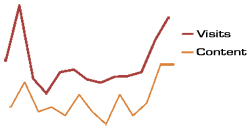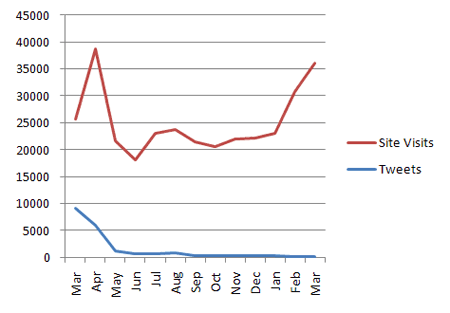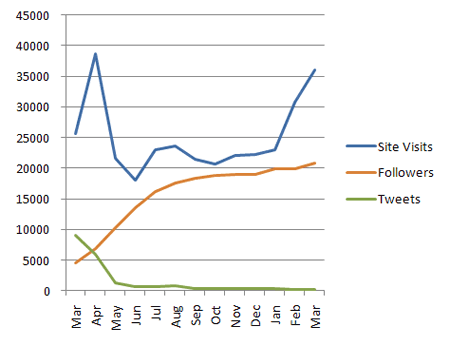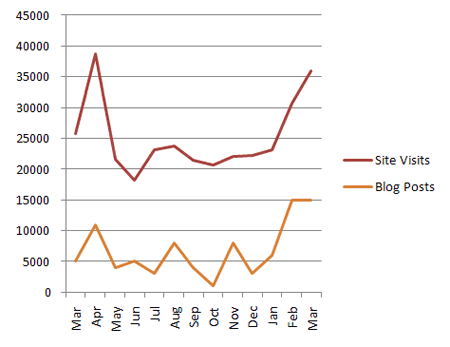
Twitter is a great place to gather useful information. It can also be a good place to find an audience of people who care about what you have to say. Twitter makes it easy to create a lot of business and personal connections. If you use Twitter with a little foresight, it can become an extremely valuable resource. If I did not believe this, I never would have spent the time and effort to write a book about Twitter, but blogging is even better. I am using Twitter as an example here, but much of this can be applied to other social media resources as well. What I wish to show is that many tools may be used for effective social media communications, and at the hub is a blog.
Many Twitter users have a blog, or even more precisely many bloggers have a Twitter account (or several). Blogs still outnumber Twitter users by hundreds of millions after all. Although Twitter can be useful, particularly in conjunction with a blog, it is not a silver bullet. I will explain this with data that I collected between March 2009 and March 2010, and provide charts to include comparisons as follows:
- Twitter update (tweet) frequency and website traffic
- Twitter followers and website traffic
- Blog frequency and website traffic
Blogging is Better than Twitter, but Twitter is Still Useful
This is not a criticism of Twitter. I like Twitter, and I find a lot of great uses for the service. I meet a lot of wonderful people, I have interesting conversations, I learn from Twitter, and I share information with people using Twitter. However, it seems that while millions of business people have been fascinated by Twitter and a handful of other social media sites, it can be easy for them to overlook the even greater value of creating excellent website content, and doing it often. Social media can bring many people to a website, but consistent and high quality content development is key to keeping them coming back and keeping them telling their friends. This is extremely valuable to most business efforts.
In order to emphasize the importance of content creation (blogging), I will illustrate the side by side growth and reach of a Twitter account and a blog which were both created near the same time. The first blog post was on 7 December 2008 and my @murnahan Twitter account was created on 9 January 2009, so about a month apart. I used Twitter in conjunction with several other sites prior to this (copmagnet.com, stormmagnet.com, and others) but my @murnahan Twitter account and this blog create a good comparison. This is a one author blog and a one author Twitter account of about the same age.
Twitter Update (tweet) Frequency and Website Traffic Comparison
Many people believe that if they tweet at high velocity all day and night that it will bring huge traffic to their website. There has been some validity to this, but the landscape has changed. It should be obvious that influence is more important than simply yelling across a room and the same is true with Twitter. Here is a chart showing numbers of Twitter updates (tweets) compared with blog visits. I will add additional metrics later, but this may be an eye-opener to some people. Since lines on a tiny chart will not do this justice, I am providing the number of actual Twitter updates I sent during this period, below the chart. The high levels of traffic in the earlier part of the chart coincide loosely with a huge numbers of tweets, but then toward the more recent months you can see that traffic went back up (after I finished writing three books in 2009) while there were many thousands fewer tweets per month. Look at March 2009 with 9091 tweets compared to March 2010 with 175 tweets month-to-date.

| Mar | Apr | May | Jun | Jul | Aug | Sep | Oct | Nov | Dec | Jan | Feb | Mar |
| 9091 | 5969 | 1272 | 659 | 671 | 850 | 314 | 406 | 329 | 400 | 355 | 238 | 175 |
Twitter Followers and Website Traffic Comparison
A lot of Twitter followers should surely do the trick, right? It seems that there has been some amazing wool pulled over Twitter users’ eyes with this myth about Twitter followers. Sure, it is great to make a lot of connections, but how does that play into actual relevant website traffic? After all, website traffic is a common reason that a lot of people use Twitter. A squillion followers is a big dream for many people, but the way Twitter follower numbers relate to website traffic is not the same as some people may imagine. There is a lot more to building a brand and building website traffic than sending a bunch of tweets to a large number of followers.

I must say that in the beginning, Twitter was massively helpful in introducing people to this blog. In those days, people were retweet crazy, and it seemed that people retweeted everything I wrote. An example is an article I wrote about Twitter retweets … it was retweeted over 400 times. It was probably actually retweeted a lot more, but that is just what tweetmeme has on record.
Twitter helped to spread the word and create a lot of incoming links from many other social media sites as well. In May 2009, I wrote about how Twitter improves blog traffic (NOTE: “improves” and not just “increases”). In social media time, that was a long time ago. Twitter still holds great value that should not be overlooked or underutilized, but Twitter is different now.
Blog Frequency and Website Traffic Comparison
Twitter gets them there, but frequent content creation keeps them coming back.
Twitter can be instrumental in generating and cultivating an audience for a particular blog topic or service offering. A chart that cannot be overlooked is the one below which shows the direct relation of blog content creation and site visits. I used actual numbers of visits to my blog, so I multiplied the blog post numbers in order to be more visible in the chart. What I wanted to point out is how the lines follow a very similar course. While comparing nearly every metric of my website traffic, the one thing that relates more closely than any other is to continually create useful information for my readers. I hope that you will see this as an important focus in your efforts, too.

A blog is a hub for good social media outreach and is what keeps the machine moving. It is where you can reach more people with the information you want to share the most. All of the many related tools in your social media marketing strategy are fantastic and should be used to the best of your abilities. In the end, the tool that is expected to create more sales for your business is your website, so take good care of it and pay attention to the numbers.
If you have not already read the following articles, I encourage you to take time for these.